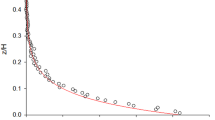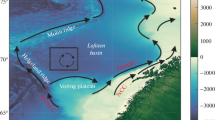Summary
In Section 1 are set out the reasons for the use of particle dynamics in this investigation. In Section 2 are solved the equations of motion for particles constrained to move along a horizontal surface under the action of a constant meridional pressure gradient force to obtain (a) velocities in spherical polar co-ordinates with naturally varying Coriolis terms, and (b) velocities and trajectories in plane cartesian co-ordinates in which the Coriolis parameter is assumed constant. Results obtained in each system are compared, showing that the plane co-ordinates as used are not significantly inaccurate, and trajectories of air particles obtained by application significantly inaccurate, and trajectories of air particles obtained by application of this system in steps of 5° of latitude are plotted to show the production of belts of convergence at some distance from the equator under the action of meridional pressure gradient forces.
The approximation of these idealised particle trajectories to actual streamlines of the air flow are discussed in Section 3, and the concept of the production of belts of convergence is used to formulate a theory of formation and maintenance of the sub-tropical anticyclones. In Section 4 this theory is applied to observed average temperature data and the calculated results compared with observed average pressure data. A possible synoptic application of the theory is then indicated in Section 5.
Zusammenfassung
Im ersten Abschnitt werden Gründe für die Anwendung der Dynamik von Massenteilchen in der vorliegenden Arbeit dargelegt. Abschnitt 2 enthält die Lösungen der Gleichungen für die Bewegung von Massenteilchen auf horizontalen Flächen unter der Einwirkung eines konstanten meridionalen Druckgradienten. Die Lösungen ergeben a) die Geschwindigkeiten in sphärischen Polarkoordinaten mit variablem Coriolis-Term (entsprechend natürlichen Verhältnissen) und b) Geschwindigkeiten und Trajektorien in ebenen kartesischen Koodinaten in denen der Coriolis-Parameter als konstant angenommen wird. Die Ergebnisse für beide Koordinatensysteme werden verglichen und es zeigt sich, daß bei Verwendung der ebenen Koordinaten keine wesentlichen Ungenauigkeiten auftreten. Zeichnet man schrittweise von 5 zu 5° (Fig. 1) die Trajektorien der Luftteilchen, so ergeben sich als Folge der meridionalen Druckgradienten Konvergenzzonen in einigem Abstand vom Äquator.
Die Annäherung dieser idealisierten Trajektorien an tatsächliche Stromlinien der Luft wird in Abschnitt3 diskutiert. An Hand der Vorstellungen von der Entstehung der Konvergenzzonen wird eine Theorie der Entstehung und Erhaltung subtropischer Antizyklonen gegeben. Im vierten Abschnitt wird diese Theorie auf beobachtete Mitteltemperaturen angewendet und die Ergebnisse der Berechnung werden mit beobachteten mittleren Luftdruckwerten verglichen. Auf eine mögliche synoptische Anwendung der vorliegenden Ergebnisse wird in Abschnitt 5 hingewiesen.
Résumé
La première partie contient les motifs de l'emploi de la dynamique de points pesants dans la présente étude. La deuxième partie donne les solutions des équations du mouvement de points pesants sur des surfaces horizontales sous l'effet d'un gradient méridien constant. Ces solutions fournissent les vitesses en coordonnées polaires sphériques avec un terme Coriolis variable, ainsi que les vitesses et les trajectoires en coordonnées cartésiennes planes en admettant un paramètre de Coriolis constant. On compare les résultats pour les deux systèmes de coordonnées et l'on constate que l'emploi des coordonnées planes n'introduit pas d'erreurs appréciables. Si l'on dessine les trajectoires de 5 en 5 degrés on voit apparaître des zones de convergence à quelque distance de l'équateur par suite des gradients méridiens.
Dans la troisième partie on discute la similitude plus ou moins grande de ces trajectoires idéalisées avec les lignes de courant réelles. Parant de l'origine possible des zones de convergence, on établit une théorie de l'origine et du maintien des anticyclones subtropicaux. Dans la quatrième partie on applique cette théorie aux températures moyennes observées et l'on compare les résultats avec les valeurs moyennes observées de la pression. Dans la cinquième partie enfin on montre l'application possible des résultats obtenus à la synoptique.
Similar content being viewed by others
References
Brooks, C. E. P., C. S. Durst and others: Upper Wind over the World. Meteorological Office, London, Geoph. Mem.85 (1950).
Brunt, D.: Physical and Dynamical Meteorology. Cambridge, p. 34 (1939).
Crossley, A. F.: The Motion of Air in Equatorial Latitude. MEM CEM/1946/1 Conference of Empire Meteorologists (1946).
Goldie, A. H. R.: Estimated Distribution of Temperature, Pressure and Wind to the 45 km Level. M. R. P. No. 360, Meteorological Office, London (1948).
Grimes, A.: The Movement of Air across the Equator. Memoirs of the Malayan Meteorological Service, v. 2 (1937).
Forsdyke, A. G.: Weather Forecasting in Tropical Regions. Geophysical Memoirs No. 82, p. 7 (1949).
Forsythe, G. E.: Exact Particle Trajectories for Non-Viscous Flow in a Place with a Constant Coriolis Parameter. J. Meteorology,6, 33 (1949).
Hess, S. L.: Some New Meridional Cross-Sections through the Atmosphere. J. Meteorology5, 293 (1948).
McVittie, G. C.: The Equations Governing the Motion of a Perfect Gas Atmosphere. J. Applied Mathematics,2, 174 (1948).
Monthly Meteorological Charts of the Atlantic Ocean. Meteorological Office, London, 1945.
Gordon, A. H.: The Relation between the Mean Vector Surface Wind and the Vector Pressure Gradient over the Oceans. Geofisica pura e applicata,21, 49 (1952).
—: Seasonal Fluctuations in the Belts of Maximum Convergence and Divergence in the South Atlantic Ocean. Quart. J. R. Met. Soc.77 302 (1951).
Author information
Authors and Affiliations
Additional information
With 1 Figure.
This paper is published with the permission of the Director of the meteorological Office.
Rights and permissions
About this article
Cite this article
Gordon, A.H., Shaw, P.M. Application of particle dynamics to derive a general circulation in low latitudes. Arch. Met. Geoph. Biokl. A. 6, 319–333 (1954). https://doi.org/10.1007/BF02247002
Issue Date:
DOI: https://doi.org/10.1007/BF02247002




